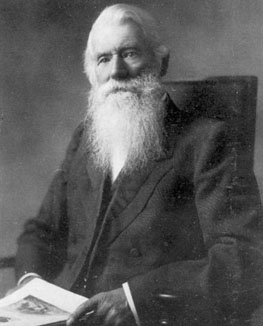| Sir Joseph Wilson Swan  Born: 31-Oct-1828 Born: 31-Oct-1828
Birthplace: Sunderland, Durham, England
Died: 27-May-1914
Location of death: Warlingham, Surrey, England
Cause of death: unspecified
Gender: Male
Race or Ethnicity: White
Occupation: Physicist, Inventor Nationality: England
Executive summary: Light bulb, photographic printing English physicist and electrical experimenter, born at Sunderland on the 31st of October 1828. After serving his apprenticeship with a chemist in his native town, he became first assistant and later partner in a firm of manufacturing chemists in Newcastle. Among its operations this firm included the manufacture of photographic plates, and thus Swan was led to one of the advances in photography with which his name is associated -- the production of extremely rapid dry plates, which were the outcome of an original observation made by him on the effect of heat in increasing the sensitiveness of a gelatino-bromide of silver emulsion.
In 1862 he patented the first commercially practicable process for carbon printing in photography. This depended on the fact that when gelatine is exposed to light in the presence of bichromate salts it is rendered insoluble and non-absorbent of water. Swan took a surface of gelatine, dusted over with lampblack and sensitized with bichromate of ammonium, and exposed it to light below a photographic negative; the result was to make the gelatine from the surface downwards insoluble to a depth depending on the intensity, and therefore penetration, of the light which had reached it through the negative. In this operation the surface of the gelatine was also rendered insoluble, and it therefore became necessary to get at its back in order to be able to wash away the portions that still remained soluble; this was effected by cementing the insoluble surface to a fresh sheet of paper by means of indiarubber solution, and then detaching the original support. It thus became possible to reach the soluble portions with water and to obtain a representation of the picture, though reversed as to right and left, in relief on the pigmented gelatine.
This process has been simplified and improved by subsequent workers, but in its essential features it formed the basis of some of the methods of photographic reproduction most widely used well into the 20th century. George Eastman purchased this patent. But Swan's name deserves remembrance even more in connection with the invention of the incandescent electric lamp than with improvements in photographic technique. He was one of the first to undertake the production of an electric lamp in which the light should be produced by the passage of an electric current through a carbon filament, and he was almost certainly far ahead, in point of time, of any other worker in the same field in realizing the conditions to be met and the difficulties to be overcome. So far back as 1860 he constructed an electric lamp with a carbon filament, which was formed by packing pieces of paper or card with charcoal powder in a crucible and subjecting the whole to a high temperature. The carbonized paper thus obtained he mounted in the form of a fine strip in a vacuous glass vessel and connected it with a battery of Grove's cells, which though not strong enough to raise it to complete incandescence, were sufficient to make it red-hot.
This was substantially the method adopted by Thomas Edison nearly twenty years later, after various fruitless efforts to make a practical lamp with a filament of platinum or a platinum alloy had convinced him of the unsuitability of that metal for the purpose -- a conclusion which Swan had reasoned out for himself many years before. By the time Edison had hit upon the idea of carbonizing paper or bamboo by heat to form the filament, Swan had devised the further improvement of using cotton thread "parchmentized" by the action of sulphuric acid, and it was by the aid of such carbon filaments that on the 20th of October 1880 he gave at Newcastle the first public exhibition on a large scale of electric lighting by means of glow lamps. In another method devised by him for the manufacture of filaments, collodion was squirted into a coagulating solution and the tough threads thus obtained carbonized by heat. He also devoted attention to apparatus for measuring electric currents, to the improvement of accumulators and to the conditions governing the electro-deposition of metals. He was elected a fellow of the Royal Society in 1894, and served as president of the Institution of Electrical Engineers in 1898-99 and of the Society of Chemical Industry in 1901. In the last-named year he received the honorary degree of D.Sc. from Durham University, and he was knighted in 1904. Royal Society 1894
Institution of Engineering and Technology President (1898-99)
Hughes Medal 1903
Knighthood 1904
Requires Flash 7+ and Javascript.
Do you know something we don't?
Submit a correction or make a comment about this profile
Copyright ©2019 Soylent Communications
|